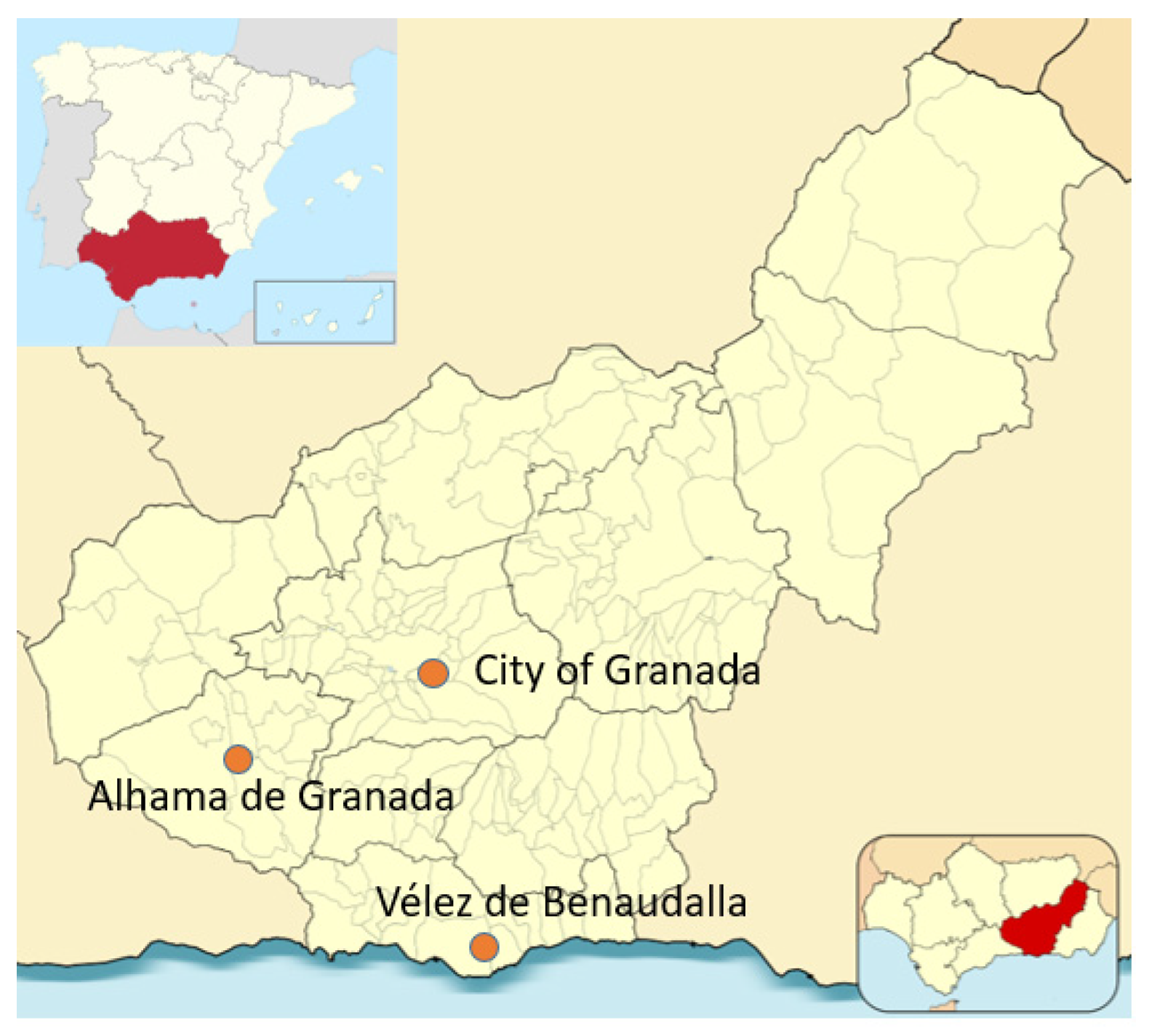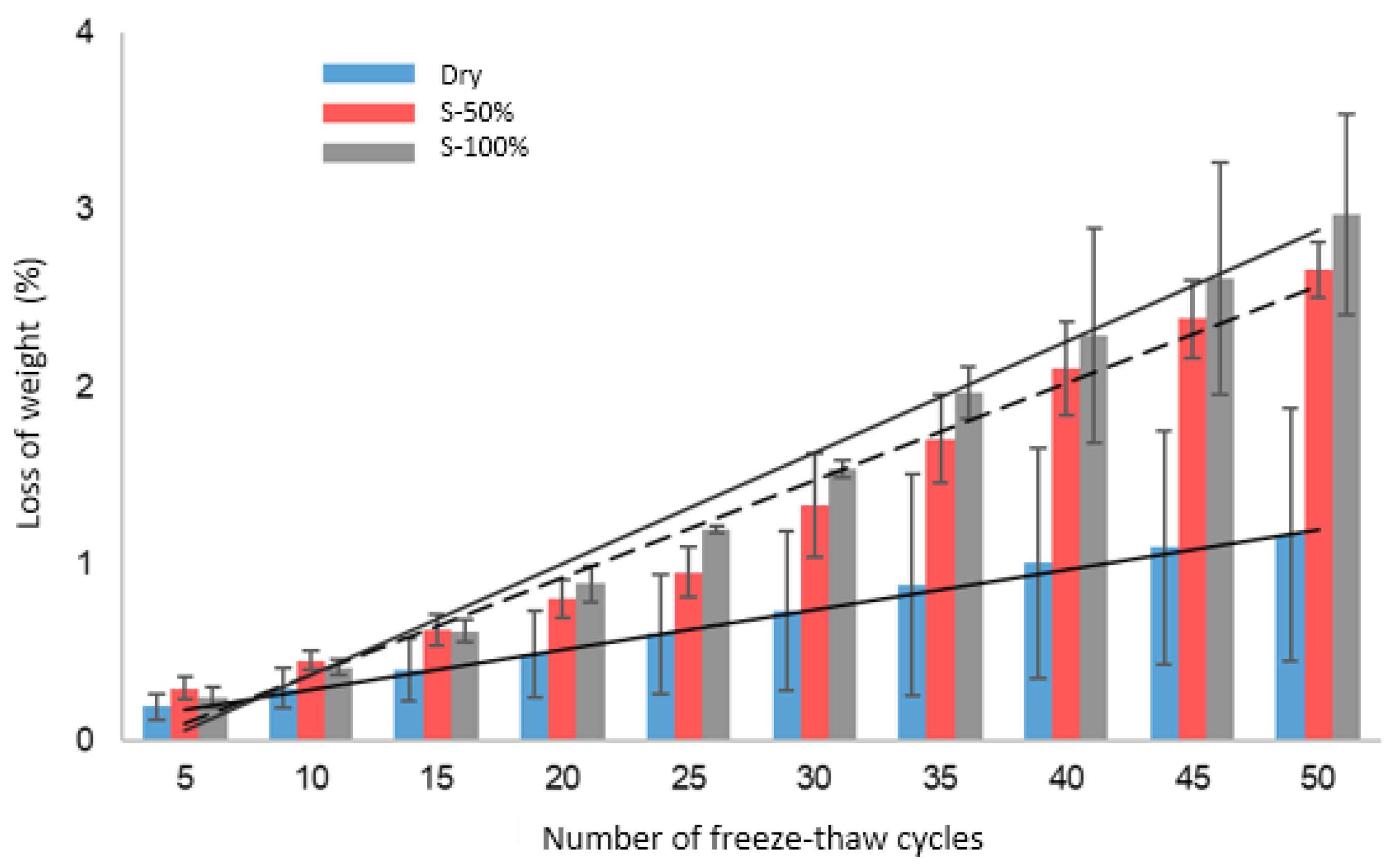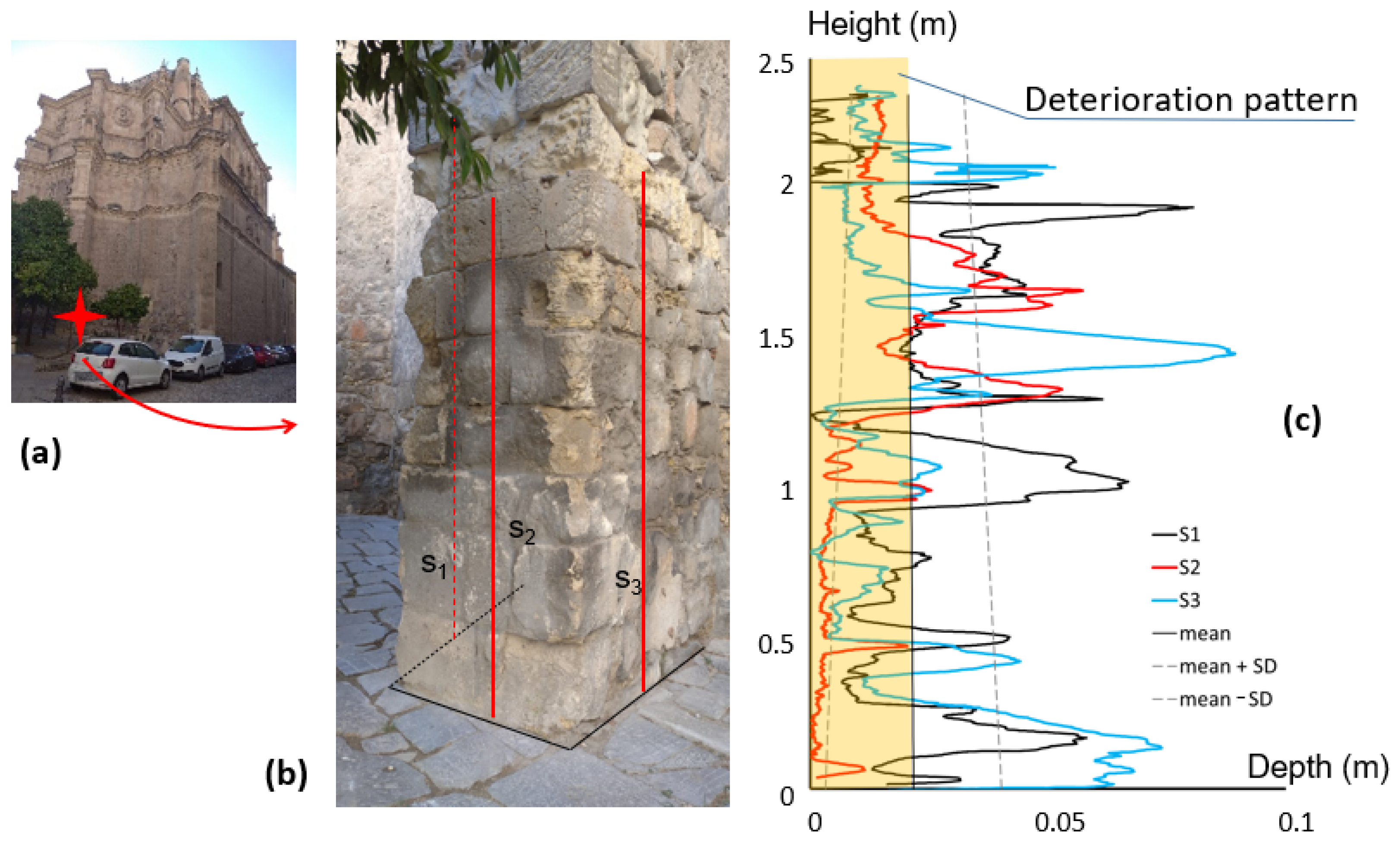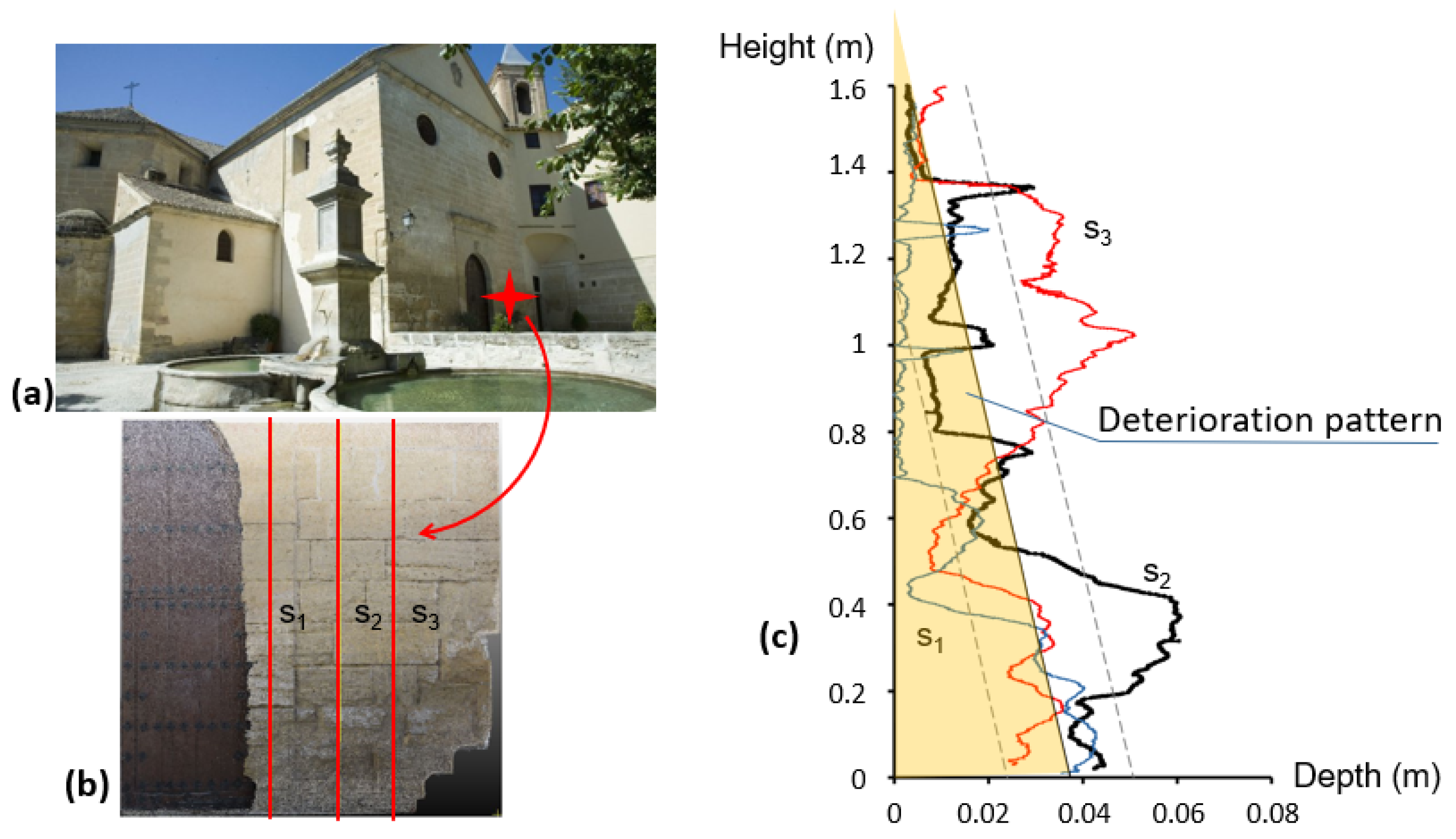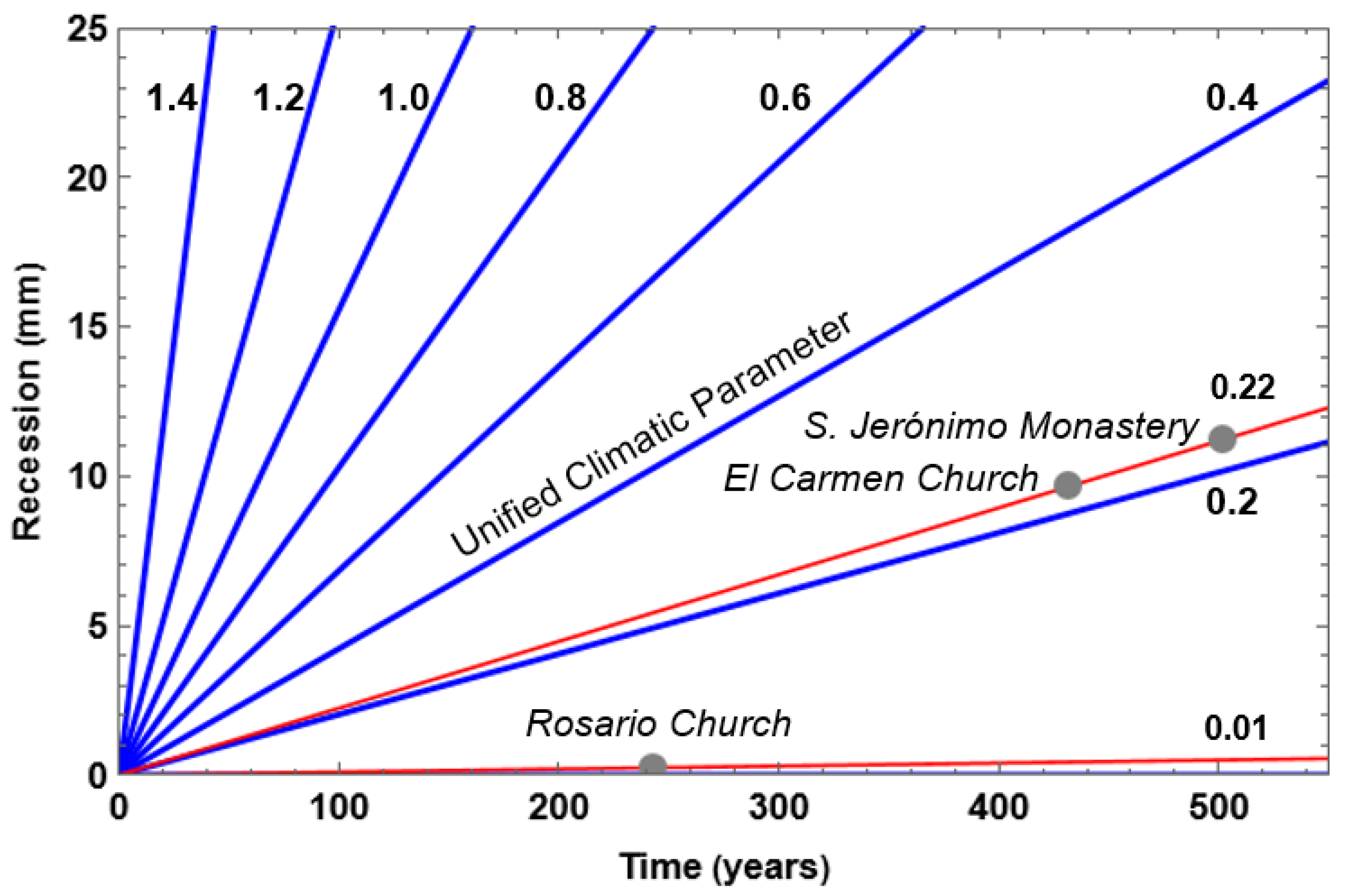1. Introduction
The deterioration of architectural heritage is a challenge for modern societies, especially because many heritage buildings are of socioeconomic importance for entire geographical areas [
1,
2]. To assess the vulnerability of the façades of these irreplaceable buildings, identifying the processes that cause this vulnerability is essential, as well as quantifying the effects of these processes [
3,
4]. Great efforts have been made to assess the safety of cultural heritage buildings. Non-destructive tests, ambient vibration tests (AVTs), laboratory tests, and long-term monitoring, among other types of tests, have been carried out to this end [
5,
6,
7,
8,
9,
10,
11]. Photogrammetry is increasingly recognized for its potential in structural assessment and heritage conservation [
12,
13,
14]. Sánchez-Aparicio et al. [
15] offer a concise and insightful review of nearly 200 publications on the detection of damage in heritage constructions based on 3D point clouds.
The first major challenge is to translate degradation and damage information into parameters to be used in the structural analysis needed to perform a resilience assessment [
16,
17,
18]. This paper explores whether photogrammetry alone can adequately capture degradation trends as climate conditions change.
It has been observed that the aging of heritage buildings is manifested, as well as in other parts, on the exterior façades, which means building deteriorate aesthetically and their structural capacity decreases [
19,
20]. Evidence shows that, in most cases, the parts of the buildings closest to the ground are the most seriously affected by degradation, and a comprehensive and analytical approach is presented in [
21]. Supported by empirical descriptions based on photogrammetry, recession patterns and their linear evolution over time have recently been proposed for the case of the San Jerónimo Monastery in Granada [
22]. Despite the innovative nature of this study [
22] and the interest it has generated, its utility could be enhanced, as it only considers the current state of the building. Consequently, deterioration is modeled solely as a linear function of the age of the building, without accounting for climate change. In order to overcome this drawback, a new methodology to measure the evolution of the deterioration as a function of both time and climate changes has been recently proposed [
23]. In [
23], laboratory-measured deterioration and photogrammetric observations were combined to model the deterioration evolution of the brick façades of Santa María dei Servi in Venice.
In the present study, the authors propose a method in which, provided that sufficient observations of buildings across diverse climates are carried out, photogrammetry alone may be sufficient to model deterioration evolution. The research analyzes long-term material degradation under different climatic conditions, relying solely on photogrammetric data to derive deterioration trends.
The deterioration of calcarenite stone is influenced by various biological, chemical, and physical processes, as well as different climatic factors. However, to formulate a mathematical model and present a robust solution, the number of unknown parameters must be compatible with the equations available. In this study, a simplified approach is adopted that considers only two climatic parameters: the mean relative humidity and the number of annual days with temperatures below zero.
Section 2 presents the different climatic scenarios studied.
Section 3 introduces the construction material analyzed, a calcarenite known as Santa Pudia (SP) stone.
Section 3 also describes a set of freeze–thaw tests performed on SP calcarenite to assess whether these test data are dispensable when sufficient observational data are available.
Section 4 outlines the deterioration patterns observed in the three heritage buildings selected for the study.
Section 5 develops the methodology proposed in this paper, and
Section 6 presents the conclusions of the study.
2. The Climatic Scenario
The province of Granada (Spain) has altitudes from 0 to 3700 masl (meters above sea level) in under 50 km. Due to this orography, the province of Granada presents different climatic conditions in a reduced area. This peculiarity has allowed the behavior of the same building material to be observed under different climatological scenarios. The building material analyzed is SP calcarenite. The procedure is based on photogrammetric observation [
24]. Three heritage buildings exposed to different climate conditions were selected, see
Figure 1. These buildings, all built between the 16th and the 17th centuries, are characterized by different climate conditions, as reported in
Table 1. Mean values of some climatic data were obtained from the regional environmental agency for the last 25 years. These heritage buildings were constructed using the same SP calcarenite, a calcarenite extensively used in constructing cultural heritage buildings throughout the province of Granada.
Given the climatology in the province of Granada and the deterioration parameters that affect Santa Pudia stone, the annual number of freeze–thaw days (n
fdy) and the mean relative humidity (RH) were chosen as the key climatic parameters (
Table 1).
Table 1 shows that at the first and third sites, the number of freeze–thaw days per year is almost the same, with slight differences in the relative humidity levels between the two locations. Warm temperatures are common throughout the year at the second site, which is near the Mediterranean coast, with higher relative humidity than the other two sites and almost no freezing days.
3. The Santa Pudia (SP) Stone
Santa Pudia stone has been widely studied because of its importance in the cultural heritage of Granada (Spain). A detailed work about the petrographic and physical characteristics of SP calcarenite was carried out in [
25], its durability and the effectiveness of treatments that could be used to enhance it were studied in [
26,
27,
28,
29,
30], and the influence of vehicle exhaust gases on the deterioration of this limestone was studied in [
31]. Recently, the main mechanical properties (compressive strength, elastic modulus, and Poisson’s ratio), the effect of high temperatures on compressive strength, and the creep behavior of SP calcarenite have been studied by using the relevant corresponding tests [
32].
It is well known that the ability to absorb and retain water is a key factor in the phenomenon of stone deterioration [
33,
34]. Water significantly affects the behavior of the materials and may cause structural damage. Indeed, deterioration caused by water (moisture and/or rain) can be attributed to several causes, such as chemical dissolution [
35], salt weathering, biological activity, and mechanical actions associated with the changes in volume when the temperature drops below zero degrees (freezing–thawing).
The porosity of the SP calcarenite ranges from 30% to 36% [
27]. It is known that the pore systems of sedimentary rocks are a key factor in the durability of building materials [
26] and that limestone is very sensitive to dissolution and freeze–thaw weathering [
33].
To verify that material deterioration can be quantified solely through observation and that additional experimental data may be unnecessary, a test campaign was conducted on SP calcarenite to assess the impact of freeze–thaw cycles under different relative humidity levels.
Freeze–Thaw Cycles for Different RHs
According to [
27], given the size of its pores and the high degree of interconnection between them, Santa Pudia stone is very susceptible to damage by freeze–thaw cycles. In [
27], SP calcarenite specimens were tested under freeze–thaw cycles, in accordance with EN 12371 [
36], to assess their behavior and frost resistance. In this test, before being frozen in air for six hours, the samples must first be dried and then submerged in water until fully saturated. After freezing, the samples are kept in water for a specified period.
In the present study, to quantify the influence of saturation degree on the deterioration of SP calcarenite, specimens with different water contents were tested under freeze–thaw cycles for up to 50 cycles. The three water contents considered were 0%, 50%, and 100%. A total of nine specimens, each measuring 120 × 120 × 50 mm, were tested (three specimens for each water content). Full saturation was achieved by submerging the specimens in water for 24 h. The average amount of water required for full saturation of the three specimens was used as a reference for 50% saturation. Each specimen was placed in a hermetically sealed plastic bag to maintain constant humidity, and each specimen was subjected to temperatures ranging from −20 °C to 15 °C in each cycle, which reasonably aligns with the daily temperature variation in the Granada province.
Each cycle consisted of 24 h freezing and thawing periods. Each sample was hermetically sealed throughout the experiment and only removed from the bags for weighing. The weight of each specimen was recorded every five cycles, and the results are summarized in
Figure 2. Regardless of water content, as the tests progressed, the specimens experienced material loss around the perimeter, with pits or small holes appearing on the surface.
As shown in
Figure 2, the number of freeze–thaw cycles and the water content significantly influence the deterioration of SP calcarenite, with freeze–thaw damage increasing as the water content rises [
37]. However, the level of deterioration was not as severe as that observed by [
27] using the EN 12371 [
36] test, possibly due to the size effect and differences in the freeze–thaw procedure described above.
For the samples tested (with dimensions: 120 × 120 × 50 mm), a uniform recession R (in mm) can be estimated as follows:
where V
ini is the initial volume of the sample and V
loss is the volume lost during the freeze–thaw test (W
ini and ΔW represent initial weight and weight variation, respectively).
In the next section, deterioration patterns based on observations from various heritage buildings are derived. These data are used to construct a recession diagram. Although laboratory data are not required for the development of the diagram, these data are included to demonstrate that they become redundant when sufficient field data are available.
4. Deterioration Patterns
Photogrammetric observations were used to adapt deterioration patterns to the façades of the three heritage buildings analyzed. As observed, deterioration is only present at the bottom parts of the façades. Rectangular and triangular deterioration patterns were assumed [
7] as the best fit to the photogrammetric data.
Figure 3 shows a buttress of the San Jerónimo Monastery in the City of Granada. Three cross-sections, obtained with photogrammetry, were chosen as representative of each one of the sides of the buttress. Based on a statistical analysis of the three cross-sections, a rectangular deterioration pattern was adjusted to the current state of the buttress, as shown in
Figure 3.
Figure 4 shows part of the main gate of Del Carmen Church in Alhama de Granada, where a triangular deterioration pattern was adjusted.
Average patterns of the analyzed buildings were obtained.
Table 2 summarizes the main parameters deduced at the three monuments studied. Except for the buttresses of the San Jerónimo Monastery, triangular deterioration patterns were considered, as suggested in [
22] for SP calcarenite in Granada. The mean degraded area and the standard deviation of the adjusted deterioration patterns are shown in the last two columns of
Table 2. It can be observed that there is less deterioration at Nuestra Señora del Rosario in Vélez de Benaudalla, a location near the coast. The most severe deterioration is found on the buttresses located behind the apse of the San Jerónimo Monastery, probably caused by the heterogeneity of the SP calcarenite.
In the seventh column of
Table 2, the value of equivalent constant mean recession (R), calculated by dividing the average deteriorated area by the height affected for degradation, is indicated.
Table 2 shows that the constant mean recession (R) at del Carmen Church in Alhama is 21.4 mm, which leads to an average loss of 0.05 mm/year. In the case of the San Jerónimo Monastery, the average loss is 0.024 mm/year, while at Nuestra Señora del Rosario Church (near the coast), it is 0.00091 mm/year.
In light of
Table 1 and
Table 2, it can be concluded that the number of days with temperatures below zero is a more important factor in the deterioration of SP calcarenite than relative humidity. Furthermore, the trend in the on-site observed data from the three historical heritage buildings matches the laboratory data for the SP calcarenite. This observation is compatible with the fact that, due to the high porosity of SP calcarenite, dew—which penetrates the rock every day—could be a factor that favors the deterioration of this stone when it is subjected to daily freeze–thaw cycles.
5. The Methodology
The first step of the proposed methodology consists of defining a Unified Climatic Parameter (UCP) for a specific building material, in this case SP calcarenite. This UCP is a linear combination of the climatic parameters (cp
i) affecting the deterioration process of the building material, calculated with Equation (2), where a
i is the weighting coefficients for the studied material and for all the deterioration parameters (cp
i) considered. In the case of SP calcarenite in the province of Granada, two climatic parameters are considered: the number of freezing days per year (n
fdy) and the mean relative humidity (RH) (see
Figure 5) [
23].
To obtain a simple relation for the evolution of the recession (R, in mm) that is easy to compute, and considering that Tan[x] is nearly linear for values of x in the interval [−0.5, 0.5], the expression proposed in [
23] is adopted to calculate the recession value:
Here, t represents the number of exposed years, and ξ is the parameter used to adjust the UCP to the photogrammetric value observed on site.
Equation (3) applies to a single climate condition. If climatic parameters change over time, Equation (4) should be used:
The recession obtained with photogrammetry is shown in the seventh column of
Table 2 (column 6 divided by column 5). For the case studied, Equation (3) is expanded to a non-linear system of 3 equations with three unknowns (
ξ, a
1, and a
2) obtained from observation. Each of the equations corresponds to one of the buildings studied, as specified in the previous section:
The system of equations in Equation (5) is solved by using weighted least squares, with the condition that the UCP is π/2 for the worst-case scenario of the climatic parameters (i.e., 365 days per year with temperatures below zero and 100% relative humidity). Using this approach, the values obtained for the three parameters are as follows: ξ = 0.1, a1 = 4.27 × 10−3, and a2 = 1.02 × 10−4.
To validate the method, the data obtained from the laboratory are incorporated into the set of non-linear equations (Equation (5)). The number of freeze–thaw cycles is considered as the number of freezing days. Experimental data corresponding to 50 freeze–thaw cycles in
Figure 2 are used in the weighted least squares through Equation (1). In this case, the values of the unknowns in Equation (3) change slightly: ξ = 0.109, a
1 = 4.28 × 10
−3, and a
2 = 0.95 × 10
−4.
Hereinafter, the following expressions will be adopted for the UPC and R (see Equations (2) and (3)), respectively:
The recession function in Equation (7) is shown in
Figure 6 for different values of the UCP, along with the predicted values for the three study cases. As can be seen, the recession values for these cases are consistent with the mean and standard deviations provided in
Table 2.
In the procedure proposed, the recession is calculated once the UCP and the time (years) of application of these climatic conditions have been discovered. If the climatic conditions change within the time interval considered, the method proposed can also be applied using Equation (4) by summing the recession caused over time for each of the acting climate parameters.
Global warming induces a reduction in the number of freezing days per year, which reduces the UCP value and therefore slows down the deterioration of the building material, as can be deduced from
Figure 6. These results align with findings from other researchers [
38], suggesting that global warming may have a positive effect on the deterioration of heritage buildings.
As shown in
Figure 6, for a specific heritage structure built with Santa Pudia stone, façade deterioration can be estimated as a function of climatic conditions (represented by the Unified Climatic Parameter) and time. Recession (R, in mm) follows a triangular pattern, affecting the lower portion of the wall. Once the updated geometry has been defined, structural analysis can be performed to assess the resulting loss in structural capacity.
6. Conclusions
In this study, a novel methodology linking climate conditions to the deterioration of building materials over time was applied to Santa Pudia calcarenite. This approach relies on measuring structural deterioration patterns, which, in this study, were obtained with photogrammetry. The method is applicable when multiple monumental buildings constructed from the same material, and exposed to different environmental conditions, are analyzed.
A single parameter, the Unified Climatic Parameter (UCP), which encompasses the relevant climatic factors affecting a specific deterioration process of a building material, is defined. In the present case, two climatic parameters were considered.
The graphical representation of the degradation pattern as a function of time and of the UCP enables future deterioration levels to be predicted. The Deterioration Evolution Diagram (DED) presented was developed for Santa Pudia stone under climatic conditions characteristic of the Mediterranean region. However, the methodology proposed can easily be extrapolated to other sites, types of materials, and climatic conditions.
The DED enables the long-term deterioration of materials used for cultural heritage buildings to be predicted, and thus it is potentially a very useful tool for planning maintenance or restoration.
Author Contributions
Conceptualization, E.H.-M. and L.M.G.-M.; methodology, P.F.; software, L.H.-G.; validation and formal analysis, P.F. and L.H.-G.; investigation, all; writing—original draft preparation, E.H.-M. and L.M.G.-M.; writing—review and editing, E.H.-M.; supervision, L.M.G.-M.; project administration and funding acquisition, E.H.-M. All authors have read and agreed to the published version of the manuscript.
Funding
This work is part of the HYPERION project (
https://www.hyperion-project.eu/ accessed 31 May 2025). HYPERION has received funding from the European Union’s Framework Programme for Research and Innovation (Horizon 2020) under grant agreement no. 821054. The content of this publication is the sole responsibility of UGR and does not necessarily reflect the opinion of the European Union.
Institutional Review Board Statement
Not applicable.
Informed Consent Statement
Not applicable.
Data Availability Statement
Dataset available on request from the authors.
Acknowledgments
The first author is a Spanish Government student fellow in the Department of Civil Engineering of the University of Granada under the supervision of Fernández (Beca de Iniciación a la Investigación 2023/2024, P5.A007). This support is gratefully acknowledged.
Conflicts of Interest
The authors declare no conflicts of interest.
Abbreviations
The following abbreviations are used in this manuscript:
| cp | Climatic parameter |
| DED | Deterioration Evolution Diagram |
| nfdy | Annual number of freeze–thaw days |
| R | Uniform recession |
| RH | Relative Humidity |
| SP | Santa Pudia |
| UCP | Unified Climatic Parameter |
References
- Pizarro-Reyes, L.; Díaz-Lazcano, V.; Zumelzu, A.; Prieto, A.J. Resilience and sustainability assessment of cultural heritage and built environment: The Libertad pedestrian walkway in Valdivia, Chile. J. Cult. Herit. 2022, 53, 154–164. [Google Scholar] [CrossRef]
- Chen, S.; Chen, J.; Yu, J.; Wang, T.; Xu, J. Prediction of Deterioration Level of Heritage Buildings Using a Logistic Regression Model. Buildings 2023, 13, 1006. [Google Scholar] [CrossRef]
- Burns, G. Deterioration of our cultural heritage. Nature 1991, 352, 658–660. [Google Scholar] [CrossRef]
- Hedayatnia, H.; Van Den Bossche, N. The Impact of Climate Change on Material Degradation: Finding a Feasible Approach for Climate Model Evaluation; International Center for Numerical Methods in Engineering (CIMNE): Barcelona, Spain, 2020. [Google Scholar] [CrossRef]
- Zhang, Q.; Liu, Y.; Dai, F. Deterioration of flawed sandstone after freeze-thaw treatment considering frost heave pressure. J. Rock Mech. Geotech. Eng. 2025. [Google Scholar] [CrossRef]
- Ruedrich, J.; Seidel, M.; Rothert, E.; Siegesmund, S. Length changes of sandstones caused by salt crystallization. Geol. Soc. Lond. Spec. Publ. 2007, 271, 199–209. [Google Scholar] [CrossRef]
- Koukouvelas, I.K.; Kyriou, A.; Nikolakopoulos, K.G.; Dimaris, G.; Pantelidis, I.; Tsikos, H. Geological and 3D Image Analysis Toward Protecting a Geosite: The Case Study of Falakra, Limnos, Greece. Minerals 2025, 15, 148. [Google Scholar] [CrossRef]
- Liu, X.; Koestler, R.J.; Warscheid, T.; Katayama, Y.; Gu, J.-D. Microbial deterioration and sustainable conservation of stone monuments and buildings. Nat. Sustain. 2020, 3, 991–1004. [Google Scholar] [CrossRef]
- Gara, F.; Vanni, N.; Davide, A.; Leonardo, C.; Leoni, G. Model Updating of Cultural Heritage Buildings Through Swarm Intelligence Algorithms. Int. J. Archit. Herit. 2025, 19, 259–275. [Google Scholar] [CrossRef]
- Masciotta, M.-G.; Ramos, L.F.; Lourenço, P.B. The importance of structural monitoring as a diagnosis and control tool in the restoration process of heritage structures: A case study in Portugal. J. Cult. Herit. 2017, 27, 36–47. [Google Scholar] [CrossRef]
- Kantaros, A.; Ganetsos, T.; Petrescu, F.I. Three-Dimensional Printing and 3D Scanning: Emerging Technologies Exhibiting High Potential in the Field of Cultural Heritage. Appl. Sci. 2023, 13, 4777. [Google Scholar] [CrossRef]
- Gómez-Gil, A.; Patrucco, G.; Lerma, J.L. Traditional and New Sensing Techniques Combination for the Identification of the Forgotten “New Flour-Weighing House” in Valencia, Spain. Appl. Sci. 2024, 14, 11962. [Google Scholar] [CrossRef]
- Javadnejad, F.; Daniel, T.G.; Christopher, E.P.; Slocum, R.K. A photogrammetric approach to fusing natural colour and thermal infrared UAS imagery in 3D point cloud generation. Int. J. Remote Sens. 2020, 41, 211–237. [Google Scholar] [CrossRef]
- Bianchi, M.G.; Casula, G.; Cuccuru, F.; Fais, S.; Ligas, P.; Ferrara, C. Three-dimensional imaging from laser scanner, photogrammetric and acoustic non-destructive techniques in the characterization of stone building materials. Adv. Geosci. 2018, 45, 57–62. [Google Scholar] [CrossRef]
- Sánchez-Aparicio, L.J.; del Blanco-García, F.L.; Mencías-Carrizosa, D.; Villanueva-Llauradó, P.; Aira-Zunzunegui, J.R.; Sanz-Arauz, D.; Pierdicca, R.; Pinilla-Melo, J.; Garcia-Gago, J. Detection of damage in heritage constructions based on 3D point clouds. A systematic review. J. Build. Eng. 2023, 77, 107440. [Google Scholar] [CrossRef]
- Baraccani, S.; Palermo, M.; Azzara, R.M.; Gasparini, G.; Silvestri, S.; Trombetti, T. Structural interpretation of data from static and dynamic structural health monitoring of monumental buildings. Key Eng. Mater. 2017, 747, 431–439. [Google Scholar] [CrossRef]
- Baraccani, S.; Silvestri, S.; Gasparini, G.; Palermo, M.; Trombetti, T.; Silvestri, E.; Lancellotta, R.; Capra, A. A Structural Analysis of the Modena Cathedral. Int. J. Archit. Herit. 2016, 10, 235–253. [Google Scholar] [CrossRef]
- O’Brien, G.; O’keefe, P.; Jayawickrama, J.; Jigyasu, R. Developing a model for building resilience to climate risks for cultural heritage. J. Cult. Herit. Manag. Sustain. Dev. 2015, 5, 99–114. [Google Scholar] [CrossRef]
- Silveira da Costa, V.; Aline, M.d.S.; da Silva Torres, A. Evaluation of Degradation State of Historic Building Facades through Qualitative and Quantitative Indicators: Case Study in Pelotas, Brazil. Int. J. Archit. Herit. 2022, 16, 1642–1665. [Google Scholar] [CrossRef]
- Castro, W.; Souza, J.; Gaspar, P.; Silva, A. Mapping the Risk of Occurrence of Defects in Façades with Ceramic Claddings. Buildings 2023, 13, 1209. [Google Scholar] [CrossRef]
- Miran, F.D.; Husein, H.A. Evaluating Deterioration Causes and Defect Patterns in Heritage Buildings: A Comprehensive Analytical Approach. Int. J. Archit. Herit. 2024, 1–20. [Google Scholar] [CrossRef]
- Jalón, M.L.; Chiachío, J.; Gil-Martín, L.M.; Hernández-Montes, E. Probabilistic identification of surface recession patterns in heritage buildings based on digital photogrammetry. J. Build. Eng. 2020, 34, 101922. [Google Scholar] [CrossRef]
- Hernández-Montes, E.; Hdz-Gil, L.; Coletti, C.; Dilaria, S.; Germinario, L.; Mazzoli, C. Prediction Model for the Evolution of the Deterioration of Bricks in Heritage Buildings in Venice Caused by Climate Change. Heritage 2023, 6, 483–491. [Google Scholar] [CrossRef]
- Gil-Martín, L.-M.; Hdz, L.; Kohrangi, M.; Menéndez, E.; Hernández-Montes, E. Fragility Curves for Historical Structures with Degradation Factors Obtained from 3D Photogrammetry. Heritage 2022, 5, 3260–3279. [Google Scholar] [CrossRef]
- Molina Piernas, E. Influencia de la textura, del Sistema Poroso y del Acabado Superficial en la Durabilidad de Areniscas y Travertino Explotados en Andalucía y Utilizados en Construcción. Ph.D. Thesis, University of Granada, Granada, Spain, 2015. [Google Scholar]
- Molina, E.; Cultrone, G.; Sebastián, E.; Alonso, F.J.; Carrizo, L.; Gisbert, J.; Buj, O. The pore system of sedimentary rocks as a key factor in the durability of building materials. Eng. Geol. 2011, 118, 110–121. [Google Scholar] [CrossRef]
- Molina, E.; Cultrone, G.; Sebastián, E.; Alonso, F.J. Evaluation of stone durability using a combination of ultrasound, mechanical and accelerated aging tests. J. Geophys. Eng. 2013, 10, 035003. [Google Scholar] [CrossRef]
- Luque, A.; Cultrone, G.; Sebastián, E.; Cazalla, O. Effectiveness of stone treatments in enhancing the durability of bioclastic calcarenite in (Granada, Spain). Mater. Construcción 2008, 58, 115–128. [Google Scholar] [CrossRef]
- Vázquez, P.; Alonso, F.J.; Carrizo, L.; Molina, E.; Cultrone, G.; Blanco, M.; Zamora, I. Evaluation of the petrophysical properties of sedimentary building stones in order to establish quality criteria. Constr. Build. Mater. 2013, 41, 868–878. [Google Scholar] [CrossRef]
- Cultrone, G.; Sebastia, E.; Ortega Huertas, M. Durability of masonry systems: A laboratory study. Constr. Build. Mater. 2007, 21, 40–51. [Google Scholar] [CrossRef]
- Rodriguez-navarro, C.; Sebastian, E. Role of particulate matter from vehicle exhaust on porous building stones (limestone) sulfation. Sci. Total Environ. 1996, 187, 79–91. [Google Scholar] [CrossRef]
- Gil-Martín, L.M.; Fernández-Ruiz, M.A.; Hernández-Montes, E. Mechanical characterization and creep behavior of a stone heritage material used in Granada (Spain): Santa Pudia calcarenite. Rock Mech. Rock Eng. 2022, 55, 5659–5669. [Google Scholar] [CrossRef]
- Ghobadi, M.H.; Torabi-Kaveh, M. Assessing the potential for deterioration of limestones forming Taq-e Bostan monuments under freeze–thaw weathering and karst development. Environ. Earth Sci. 2014, 72, 5035–5047. [Google Scholar] [CrossRef]
- Lerma, J.L.; Cabrelles, M.; Portalés, C. Multitemporal thermal analysis to detect moisture on a building façade. Constr. Build. Mater. 2011, 25, 2190–2197. [Google Scholar] [CrossRef]
- Maravelaki, P.; Bertoncello, R.; Biscontin, G.; Battaglin, G.; Zendri, E.; Tondello, E. Investigations of the Surface Processes on Exposed Limestones. MRS Proc. 1992, 267, 943. [Google Scholar] [CrossRef]
- UNE EN 12371; Natural Stone Test Methods—Determination of Frost Resistance. AENOR: Madrid, Spain, 2011.
- Chen, L.; Li, K.; Song, G.; Zhang, D.; Liu, C. Effect of freeze–thaw cycle on physical and mechanical properties and damage characteristics of sandstone. Sci. Rep. 2021, 11, 12315. [Google Scholar] [CrossRef]
- Prieto, A.J.; Verichev, K.; Silva, A.; de Brito, J. On the impacts of climate change on the functional deterioration of heritage buildings in South Chile. Build. Environ. 2020, 183, 107138. [Google Scholar] [CrossRef]
| Disclaimer/Publisher’s Note: The statements, opinions and data contained in all publications are solely those of the individual author(s) and contributor(s) and not of MDPI and/or the editor(s). MDPI and/or the editor(s) disclaim responsibility for any injury to people or property resulting from any ideas, methods, instructions or products referred to in the content. |
© 2025 by the authors. Licensee MDPI, Basel, Switzerland. This article is an open access article distributed under the terms and conditions of the Creative Commons Attribution (CC BY) license (https://creativecommons.org/licenses/by/4.0/).
